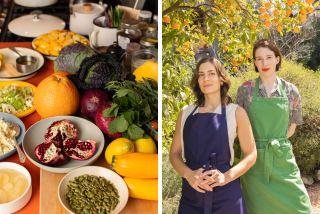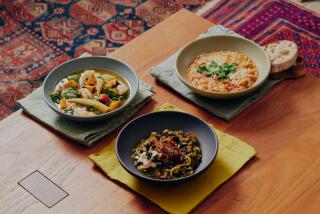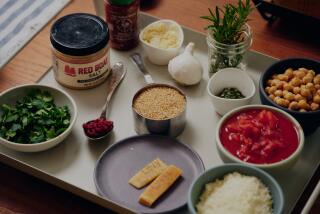Comfort by the bowlful
AND now we enter the soup season. In the face of such recent challenges as being buffeted by freezing temperatures, battling the flu or simply recovering from the lingering effects of holiday overeating, there is nothing quite so restorative as a bowl of soup.
And there are few things that are easier to fix than a soup made just from vegetables. No long simmering of meaty bones or tough cuts, no complicated stocks. Build a vegetable base and then add water. That’s basically it. You don’t even need to use broth — as the vegetables simmer they’ll release their own.
A well-made vegetable soup has just about everything you could want in a winter dish — a balanced complexity of flavors, a soothing warmth, just enough heft to sustain, and a surprising lightness despite its big taste.
These soups are a pleasure, not a penance. Serve them with good bread and cheese, and maybe some tangerines and cookies for dessert, and you’ve got an incredibly satisfying meal.
Still, though they can be assembled with a fairly free hand, nothing about the preparation of these soups should be haphazard. Like all good cooking, a pot of soup needs to be carefully thought out.
For meat-eaters, the hardest part of making vegetarian soups is coming up with a combination of ingredients that has enough substance to make you feel like you’ve eaten.
Throw a bunch of root vegetables in a pot and you’ll get something that tastes pretty good — think of first-course soups made from puréed potatoes or carrots. But it will lack the body that can let a soup be the center of a meal.
Finding a substitute that doesn’t involve meat takes some creativity. The best solution is beans. Because they’re naturally high in protein and have a dense, meaty texture, beans fill in nicely, giving the vegetables the balance they need.
Generally, the best soups are made by starting from scratch with dried beans. As the beans soften during cooking, they release starch that thickens the broth, giving it body and savor.
And starting with dried beans is not as much bother as you might think. You don’t need to soak them in advance; in fact, the texture of the broth will be infinitely better if you don’t. They do take a little longer to cook this way, but usually less than three hours — and for almost all that time the pot is sitting by itself, bubbling merrily away in the oven or on the stovetop.
Lentils are even easier. They’ll cook in less than an hour and have a pleasantly peppery, meaty flavor.
The most notable exception to the whole from-scratch thing is dried garbanzo beans or chickpeas, which really do need to be soaked to get the cooking time down from days to hours. Canned chickpeas are a boon for soup and stew makers. Rinse them well to get rid of the tinny-tasting canning liquid, and you’ll be hard-pressed to tell them apart from beans you took a couple of days preparing.
*
Leisurely cooking
AFTER that, though, vegetable soups are a breeze. The actual preparation isn’t terribly demanding and it’s leisurely paced. A half-hour’s worth of chopping and slicing is usually plenty. That’s just enough to make you feel like you’re actually cooking without coming close to crossing over into drudgery.For the most part, you don’t even need to pay that close attention. Exact shapes and sizes of cuts aren’t critical. No perfectly cubed mirepoix here; chop the vegetables as neatly or as sloppily as you wish. Just make sure that things with similar textures are cut in similar sizes so they’ll cook evenly.
And almost all of the actual cooking is done over low enough heat that you’d have to take a mighty long nap to risk burning anything.
The white bean and fennel soup has a thick, rich-flavored broth that comes mostly from the cooking liquid from the beans. What really makes the soup sing, though, is three levels of fennel flavor — silky sweet from the stewed bulbs, aromatic and herbaceous from the chopped fronds, and nutty and caramelized from the quickly fried wedges that are added as a garnish.
In the soup with winter greens and chickpeas, it’s the braised greens that give the dish its savor. The more kinds you use, the better the broth will be. Prop a couple of toasted baguette slices in the bottom of each soup bowl to soak it all up. A finishing grace note of grated Parmigiano-Reggiano ties the whole thing together.
If you’ve ever wondered just how sweet cabbages and root vegetables can be, try the minestra. Without the peppery flavor of the lentils, it would be over the top. But along with a healthy swig of vinegar cooked off at the end, they provide just the right balance.
Ladle it into a warm bowl. Sliver some good Gruyère onto slices of bread and toast them until the cheese is browned and bubbling. Then settle in to watch a Lakers game on television. It’s winter in Southern California.
*
*
White bean and fennel soup
Total time: About 2 hours, 45 minutes
Servings: 8
Olive oil
1 onion, diced
2 carrots, diced
2 fennel bulbs
4 cloves garlic, minced
1 pound dry Great Northern or cannellini beans
1 bay leaf
Salt
1/4 cup white wine
Freshly ground black pepper
2 tablespoons best quality olive oil, divided, for garnish
1. Heat the oven to 350 degrees. Warm 2 tablespoons of olive oil in a heavy soup pot over medium-low heat. Add the onion and carrots, and cover and cook until they soften, about 20 minutes.
2. Trim the branches and fronds from both bulbs of fennel; chop at least one-third cup of the fronds, wrap tightly and refrigerate. Quarter one bulb lengthwise and cut out the solid core. Dice and add to the soup pot. Set the other bulb aside until later.
3. When the vegetables in the soup pot are softened and aromatic, stir in the garlic and cook until fragrant, 2 or 3 minutes. Add the beans, bay leaf and 8 cups of water. Cover and place in the oven to cook for 1 hour.
4. After 1 hour, remove the pot from the oven and stir in 1 1/2 teaspoons of salt. Return to the oven to finish cooking until the beans are quite tender, another 45 minutes to 1 hour, 15 minutes. Cooking time can vary quite a bit depending on the condition of the beans, so begin checking after 30 minutes.
5. When the beans are tender, remove the pot from the oven. If there are still just a few beans that are slightly chalky, that’s OK — leave the pot covered for a while and they will finish cooking from the reserved heat. If the soup loses too much moisture in the oven, add water as needed to maintain a loose, soup-like consistency.
6. In a small skillet, heat one-fourth cup of olive oil over medium heat. Quarter the remaining fennel bulb lengthwise, but do not trim the core, so the fennel bulb will stay together. Fry the bulb until well browned on all three sides, covering tightly in between turns to avoid splattering. Remove the pan from the heat momentarily to carefully add the wine, replace the cover, and cook until the fennel is tender, about 10 minutes.
7. When the fennel is tender, remove it from the pan, sprinkle with salt and cut each quarter in half lengthwise. Add these to the soup. (The dish can be prepared up to this point a day in advance and refrigerated, tightly covered.)
8. When ready to serve, warm the soup over medium heat in a covered pot. Just before serving, stir in the reserved chopped fennel fronds. Add freshly ground black pepper to taste and more salt if necessary. Ladle the soup into warm, wide soup plates and finish each with a drizzle of the best-quality olive oil. Serve immediately.
Each serving: 293 calories; 13 grams protein; 37 grams carbohydrates; 12 grams fiber; 11 grams fat; 2 grams saturated fat; 0 cholesterol; 481 mg. sodium.
**Soup with winter greens and chickpeas
Total time: About 1 hour, 30 minutes
Servings: 8
1/4 cup olive oil
2 carrots, diced
1 stalk celery, diced
1 onion, diced
1 turnip, diced
4 cloves garlic, minced
1 pound chopped mixed greens (mustard, kale,
turnip, etc.)
Salt
1/2 teaspoon minced rosemary
1 (16-ounce) can chickpeas, rinsed and drained
1/3 cup grated ParmigianoReggiano, or more, to taste plus additional to pass at the table
16 slices baguette, toasted
Freshly ground pepper
1. In a heavy soup pot, warm the olive oil over medium-low heat. Add the carrots, celery, onion and turnip, cover and cook until they have softened and become aromatic, about 20 minutes. Stir in the garlic and cook until fragrant, 2 or 3 minutes.
2. Add the mixed greens, a big handful at a time, stirring and giving them time to soften and shrink before adding the next handful.
3. When all of the greens have cooked, add 8 cups of water, one-half teaspoon salt, the rosemary and chickpeas. Bring to a simmer over medium-high heat; cover and lower the flame to maintain a simmer. Cook until the broth is deeply flavored, 45 minutes to 1 hour.
4. When ready to serve, stir in one-third cup Parmigiano-Reggiano and season to taste with salt and pepper. Arrange two toast slices in the bottom of each warm soup bowl and ladle the soup over the top. Sprinkle with more cheese to taste. Serve immediately, passing a bowl of cheese to be added at the table.
Each serving: 235 calories; 7 grams protein; 31 grams carbohydrates; 6 grams fiber; 9 grams fat; 2 grams saturated fat; 3 mg. cholesterol; 432 mg. sodium.
**Minestra of root vegetables
Total time: About 2 hours
Servings: 8
2 leeks
2 tablespoons butter
1 onion, coarsely chopped
2 carrots, coarsely chopped
2 parsnips, coarsely chopped
1 rutabaga, coarsely chopped
3 cloves garlic, minced
2 big sprigs fresh thyme
1 bay leaf
Salt and freshly ground black pepper
1 pound Savoy cabbage
2/3 cup French green lentils
2 teaspoons red wine vinegar, or more, to taste
1. Trim the tough green tops of the leeks, leaving only the white stalk behind. Cut each stalk in quarters lengthwise, cutting down to but not through the root end. Rinse well under cold running water, separating the layers of the leeks to get rid of any dirt that might be hiding there. Thinly slice both leeks crosswise.
2. Melt the butter in a heavy 4- to 6- quart soup pot over medium-low heat. Add the onions and cook until just softened, about 3 minutes. Add the leeks, carrots, parsnips and rutabaga, cover tightly and cook gently until the vegetables are bright in color, beginning to soften and become aromatic, about 5 minutes. The vegetables do not need to be added all at once; you can chop them one at a time (they should be chopped to about the same size) and add them to the pot as you go along. Add the garlic and cook about 2 to 3 minutes, until fragrant.
3. Place the thyme sprigs in the center of the bay leaf and fold the bay leaf around them. Tie with string to hold together in a packet. Or you can fold the bay and thyme in a square of cheesecloth and tie it closed. Add the herb packet to the soup and cook for a minute or two.
4. Add 8 cups of water, 2 teaspoons of salt and a generous grinding of black pepper. Raise the heat and bring to a simmer. Partially cover the pot, leaving the lid ajar, and reduce the heat to maintain a sprightly simmer. The liquid should be bubbling quickly, but not boiling
5. Cook until the vegetables have softened and their flavors have married, about 1 hour. You should not taste any individual vegetable, but a more complex combination of all of them.
6. Cut the cabbage in lengthwise quarters and cut out the solid core. Cut each quarter in half lengthwise and then slice it about one-fourth to one-half inch thick. When the soup vegetables are cooked, add the cabbage to the pot and gently stir it in. Continue to simmer until the cabbage is silky and sweet, about 30 minutes.
7. While the soup is cooking, in a separate medium saucepan, bring 6 cups of water and 1 tablespoon salt to a rolling boil. Add the lentils, reduce the heat to a simmer and, with the cover slightly ajar, cook until they are tender, about 45 minutes. Drain and set aside.
8. When you are almost ready to serve, remove the bay leaf bundle from the soup. Raise the heat under the soup to a faster simmer and add the lentils. Stir gently to avoid breaking up the root vegetables. Stir in the vinegar and let the soup cook another minute or two to lose the raw smell. Season with a generous grinding of black pepper. Taste and adjust seasoning, adding more salt, pepper or vinegar as needed, then ladle the soup into warm bowls. Serve immediately.
Each serving: 162 calories; 6 grams protein; 29 grams carbohydrates; 8 grams fiber; 4 grams fat; 2 grams saturated fat; 8 mg. cholesterol; 771 mg. sodium.
More to Read
Eat your way across L.A.
Get our weekly Tasting Notes newsletter for reviews, news and more.
You may occasionally receive promotional content from the Los Angeles Times.










